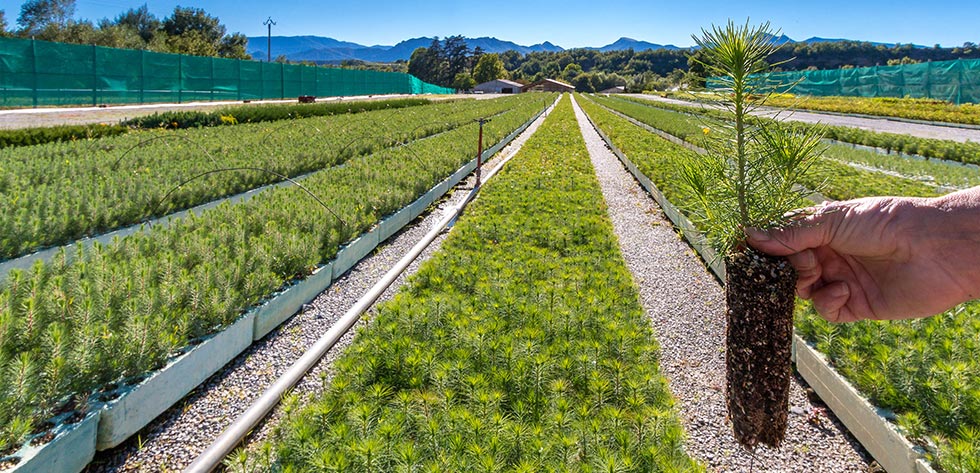
Patented anti-stump buckets
A bucket to put an end to root bunting
Truffle growers as well as experienced gardeners know that the growth of a young plant freshly transplanted into the ground depends greatly on the quality of its root system. It is therefore better to avoid "bent" plants that will have difficulty regaining their vigor and developing properly and sustainably.
It is precisely to avoid this phenomenon of root bunting that Robin Nurseries has developed a range of cups specifically designed to guide the roots of young plants. These buckets have several singularities: vertical grooves directing the roots downwards, a perforated bottom preventing the roots from rolling up at the base of the container... All of these features are designed to prevent the formation of a circular root ball.
What is a root bun and why avoid it ?
Who hasn't had the experience of unpacking a plant and finding that its root system is a real tangle? A very dense agglomeration of roots rotating in the container, with a little bit of substrate mixed in: This is called a root bun. No doubt your plant has been in its pot for a long time and needs to be repotted!
A root bun is formed as a plant's roots grow. These roots accumulate, literally spin in the pot and eventually form a mass. The longer you wait, the greater the risk of root bunting, which compromises the plant's recovery!
Why? Simply because the roots of a plant memorize (in a way) their growth trajectories. So when they are transplanted in the ground, they will reproduce their root pattern and resume their growth in a "whirlwind" instead of extending and rooting deeply. Your plant will then vegetate, or even progressively wither.
Variations of the ROBIN ANTI-CHIGNON® BUCKET
Imagined and conceived in 1970, the Robin Nurseries' anti-sprouting bucket has since undergone several improvements and variations to best meet the specific needs of truffle growers and foresters. Whatever their destination, the objective remains the same for each of our anti-rotting buckets: to perfect the quality of our young plants in order to guarantee a recovery rate close to 100%!
Today, ROBIN ANTI-CHIGNON® BUCKETS are available in two forms: expanded polystyrene honeycomb blocks and individual square cups. The characteristics of these two models are summarized below.
Honeycomb block made of xxpanded polystyrene
The plants are delivered in their honeycombed culture trays. Designed in expanded polystyrene, these containers offer 2 different volumes of cells (200 or 400 cm3) and can receive between 43 and 74 plants each.
Robin anti-chignon® R200 bucket
- Container with 200 cm3 cells (74 plants per container)Robin anti-chignon® R400 bucket
- Container with 250/400 cm3 cells (43/53 plants per container)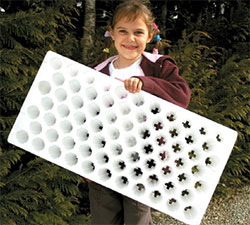
Individual square bucket
Packaged and delivered in a plastic case, this patented model is available in 4 different volumes: from 0.43 to 3 liters.
Robin anti-chignon® R430 bucket
- Volume of 0.43 liter - 45 plants per box.Robin anti-chignon® R600 bucket
- Volume of 0.6 liter - 28 plants per box.Robin anti-chignon® R1,5 bucket
- Volume of 1.5 liter - 15 plants per box.Robin anti-chignon® R3 bucket
- Volume of 3 liters - 6 plants per box.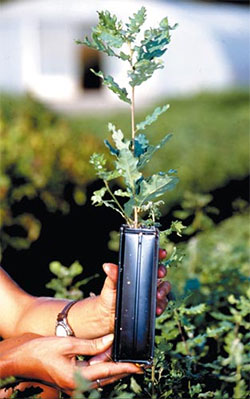
Please note that all our ROBIN TRUFFLE PLANTS and MUSHROOM PLANTS®, are grown in individual square Robin ANTI-CHIGNON® buckets and are available in the different volumes mentioned above.
Our ROBIN ANTI-CHIGNON® cups are environmentally friendly. They are systematically recovered by our trucks after planting and are reused up to 10 successive years. Therefore, we ask you to keep the empty containers at the end of your planting and to inform us so that one of our trucks can come and collect them as soon as possible.
The advantages of ROBIN ANTI-CHIGNON® buckets
The Robin anti-chignon® patent is based on a cultivation process that guarantees a superior quality for young plants raised in pots. It encourages the development of a naturally shaped root system without deformation. As you can see from the illustrations below, thanks to the ROBIN ANTI-CHUNG® CUPS and the complete self-covering obtained over the entire surface of the root ball, the natural architecture of the root system is optimal.
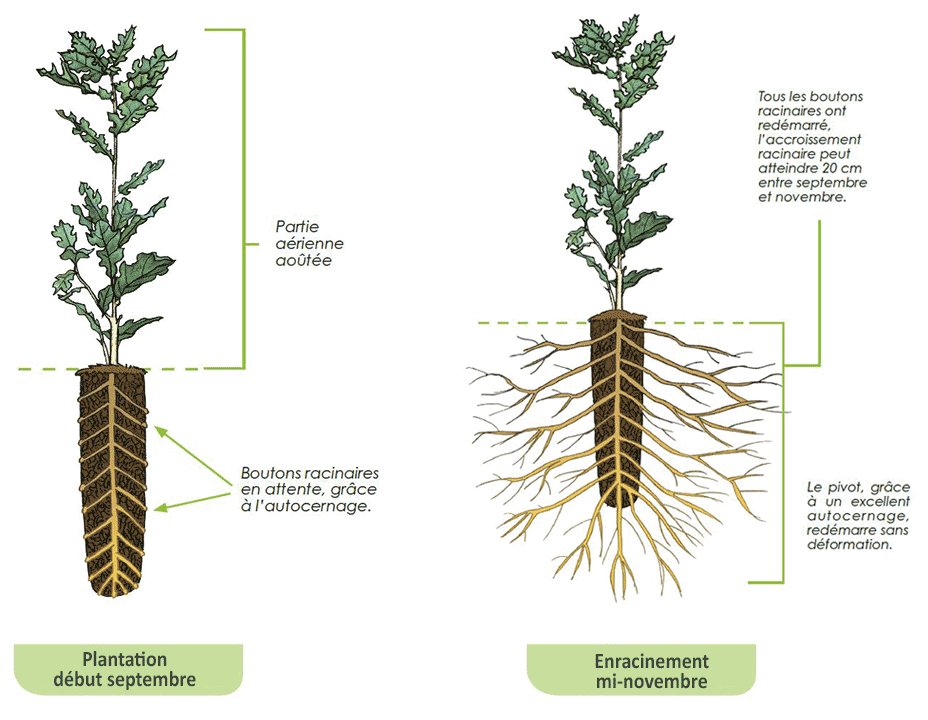
When planted in early September, the plant consists of its "August" aerial part and waiting root buds, thanks to self-nesting. From mid-November onwards, rooting is evident: All the root buds are restarted and the pivot starts again without deformation thanks to excellent self-nesting. The root growth of the young plant can thus reach 20 cm between September and November !
The many advantages of the patented ROBIN ANTI-CHIGNON® bucket system
- Anti-Bun Device : Excellent growth and development of young plants thanks to a root system without malformation.
- Integral Autocernage : On the entire surface of the mound and at the bottom of the bucket which leads to a root development with a very dense hair and without malformation, which optimizes the recovery.
- Freshness of the plants : Delivered on your sites in their growing crates, freshness is preserved during transport and waiting on the site before planting.
- Time saving : Unnecessary gauge. The clumps of regular and conical shape facilitate the setting up.
- Maneuverability : Lightweight and compact, honeycombed Robin cases are easy to handle even on rough terrain.
- Lengthening the planting period
- Recovery guarantee : We guarantee the recovery of all plants delivered in ROBIN ANTI-CHIGNON® cup with our guarantee of recovery.
Learn more about the ROBIN trade-in guarantee
Tips for the use of Robin ANTI-SCEDGE® pot plants
In order to obtain the best results with the plants you are about to receive, we would like to give you some advice concerning their storage, transport and planting.
Storage and precautions for the conservation of seedlings in cups
As soon as you receive the plants, we advise you: to store the boxes flat on the ground (the plants in an upright position), outside; sheltered from the wind. If the plants have to be stored in a shed or a cellar for specific reasons, make sure that the place is well ventilated and well lit. Never leave plants in the dark for several days in a row. If planting is delayed, you can store the plants for several days or even weeks before planting, outside and if possible in a place sheltered from the wind.
If storage in hot dry weather or windy conditions exceeds one week, the moisture content of the clods should be monitored and watered once or twice a week if necessary.
If the waiting time before planting is longer than one month, it is advisable to raise the boxes a few centimetres above the ground (4 to 10 cm) to allow for self-piercing (except during the winter - December to March - when heavy frosts may occur).
Transporting the pot plants to the planting site
You can easily transport ROBIN ANTI-CHIGNON® seedlings delivered in polystyrene boxes by stacking the boxes on their side. Just as we do when we deliver with our trucks. This will save you volume.
Planting time
• The plants in ROBIN ANTI-CHIGNON® GODET allow for longer planting periods. As the plants are delivered in their growing boxes, they can be taken out of the nursery and planted without any risk practically all year round. You can therefore start planting as early as September in the lowlands and as early as mid-August in the mountains.
• There is no need to wait for the plants to be Augusted: For Robin truffle plants, planting is possible from mid-September. And in spring, you can extend it until June without risk.
• The beginning of autumn remains the ideal period for planting young plants and truffle plants raised in anti-chignon® cups. Indeed, young plants planted in early autumn have the possibility to root before winter, because even if they are Augusted, and if the growth of the aerial part is finished. The root system continues to develop as long as the soil is still warm (up to 10°, root growth continues). This allows the young plants and truffle trees to establish themselves before winter, which avoids the risk of winter heaving and allows a much faster restart when the first heat of spring arrives.
How to transplant a plant in an anti chignon cup ?
Before planting, if the clods are dry, it is strongly recommended to water the ROBIN ANTI-CHIGNON® cups abundantly (or to soak the boxes for a few minutes in water). This will build up a moisture reserve that will allow the root system of the plants to start up very quickly.
Of course, you must ensure that the planting hole is deep enough to correctly install the root ball from the ROBIN ANTI-CHIGNON® bucket in a vertical position (take care not to compress it). The top of the root ball must be covered with 2 to 3 cm of soil to avoid wicking effects.
In order to optimize the planting technique of our ROBIN ANTI-CHIGNON® buckets, and to be sure to place the rootballs in a vertical position and at a sufficient depth, we have developed a specific planting tool (to be found in our "Robin protection" section).
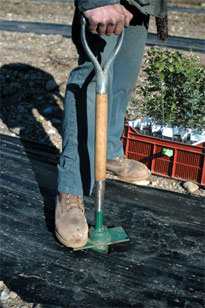
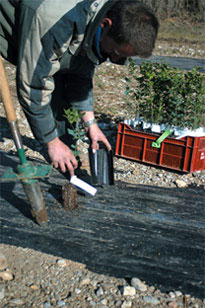
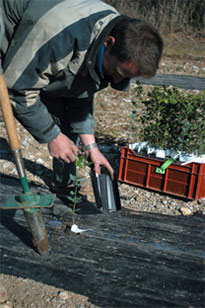
IMPORTANT : The best results (in terms of growth and recovery rate) of plants raised and delivered in ROBIN ANTI-CHIGNON® GODETS have always been observed following very early fall plantings..